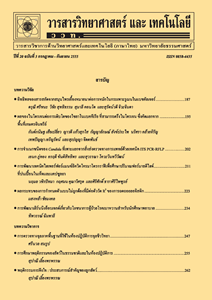ทฤษฎีฟังก์ชันนอลความหนาแน่นกับการศึกษาโครงสร้างของสารควบแน่น
Main Article Content
Abstract
บทคัดย่อ
ปัญหาระบบหลายอนุภาคคือหัวข้อที่ท้าทายสำหรับการค้นหาคำตอบที่ถูกต้องเกี่ยวกับสมบัติต่าง ๆ ในระบบของแข็ง ในยุคเริ่มต้นนั้นกลศาสตร์ควอนตัมคือวิธีการที่ประสบความสำเร็จในการอธิบายพฤติกรรมของอนุภาคเดี่ยวในความต่างศักย์ที่ถูกกำหนดขึ้น ต่อมาฮาร์ทรีและฟอร์คได้เสนอว่าฟังก์ชันคลื่นของอิเล็กตรอนหลายตัวคือสเลเตอร์ดีเทอร์มิแนนต์ที่เกิดจากฟังก์ชันคลื่นของอิเล็กตรอนเดี่ยว ทฤษฎีของฮาร์ทรีและฟอร์คสามารถอธิบายสมบัติอสมมาตรของระบบอิเล็กตรอนกลุ่มเล็ก ๆ ได้ อย่างไรก็ตาม วิธีการที่กล่าวมาทั้งหมดไม่เหมาะสมในการแก้ปัญหาของระบบหลายอนุภาค ทั้งนี้เนื่องจากการเพิ่มขึ้นอย่างทวีคูณของตัวแปรที่ไม่ทราบค่าเมื่อจำนวนอิเล็กตรอนในระบบมากขึ้น ปัจจุบันนี้ทฤษฎีฟังก์ชันนอลความหนาแน่นเป็นวิธีที่นิยมสำหรับการคำนวณสมบัติของของแข็งโดยใช้โปรแกรมคอมพิวเตอร์ ในบทความนี้กระบวนการพื้นฐานสำหรับการคำนวณพลังงานต่ำสุดในระบบของแข็งโดยใช้ทฤษฎีฟังก์ชันนอลความหนาแน่นได้อธิบาย ตัวอย่างสมบัติของของแข็งจากการคำนวณด้วยฟังก์ชันนอลความหนาแน่นได้ถูกนำเสนอและผลการคำนวณถูกเปรียบเทียบกับการทดลองก่อนหน้า
คำสำคัญ : ระบบหลายอนุภาค; ทฤษฎีฟังก์ชันนอลความหนาแน่น; ระบบของแข็ง
Abstract
Many-body problem is a challenge topic for finding the exact solution of the properties in a solid system. At the beginning, quantum mechanics is a major success method for explaining the properties of a single particle in any given potential. Later, Hartree and Fock proposed that the many-electron wave function is the Slater determinant of the single-electron wave functions. Hartree-Fock’s theory can explain the antisymmetric property of tiny-electron systems. However, these techniques are not practical for solving the solution in the systems that contain large number of electrons, which is called many-body system. Because the unknown parameters are the multiple increasing, when number of electrons increasing. Nowadays, density functional theory (DFT) is the popular method for calculating the solid properties by using computer program. In this article, the fundamental process for calculating the minimum energy of a solid system by using DFT was explained. The examples of solid properties based on DFT simulation were introduced, and the DFT calculation results were compared with the previous experiments.
Keywords: many-body problem; density functional theory; solid system


